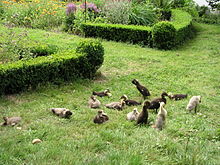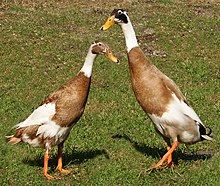Running duck

The river duck or Indian river duck , also called bottle duck , is a duck breed descending from the mallard ( Anas platyrhynchos ) . She belongs to the penguin ducks .
description
The only partially flightable duck was introduced to Europe from Southeast Asia around 1850 and then mainly bred in England . The running duck, which runs with its neck pointing straight up, has a long, slender body. She has a lively character, is very attentive and agile.
In Europe, ducks are often kept in gardens because they prefer to eat snails and snail eggs. In Asia, the animals bred for laying were primarily kept as egg suppliers. Laying capacities of more than 150 eggs per year are not uncommon even with pure gardening. The eggs are usually slightly larger than chicken eggs and have a larger egg yolk.
Running ducks are bred in Germany in the following ten colors: wild-colored (comparable to the mallard ), trout-colored, silver- wild-colored , deer-colored and white-spotted, pea-yellow, blue-yellow, white, black, brown and blue. The colors recognized in Germany must be thoroughly bred and may not split into other colors after mating.
Running ducks live on average 12–15 years old. There are also records of individual animals that lived up to 20 years old.
Legal provisions
Legally, water fowl of domestic breeds is often treated as livestock . Then the animals in Germany, depending on the legal basis of the federal states, must be registered with the responsible veterinary or regulatory office or the animal disease fund. The local building authority can find out up to what size a stable or an aviary may be built at the intended location. Depending on the type of residential area and federal state, the stable may require a permit.
attitude
Because of their relatively high for ducks runs ducks are better walk than Mallards or livestock races like the Peking duck . However, the river duck is also a water bird and needs water both for food intake and for feathers, and swimming is still one of its normal basic needs. Keeping them without adequate bathing facilities is not appropriate to the species. There should be at least 100 m² of space per duck.
Individual evidence
- ↑ Vogel-Reich, Alexandra (2015): Ente, Gans und Schwan. Breeds, husbandry, marketing. Leopold Stocker Verlag. Graz. ISBN 978-3-7020-1514-5 . P. 78ff.
literature
- Bjoern Clauss, Alexandra Vogel-Reich: Ducks. The book on the duck. Self-published, Soyen ISBN 978-3-00-034167-0


